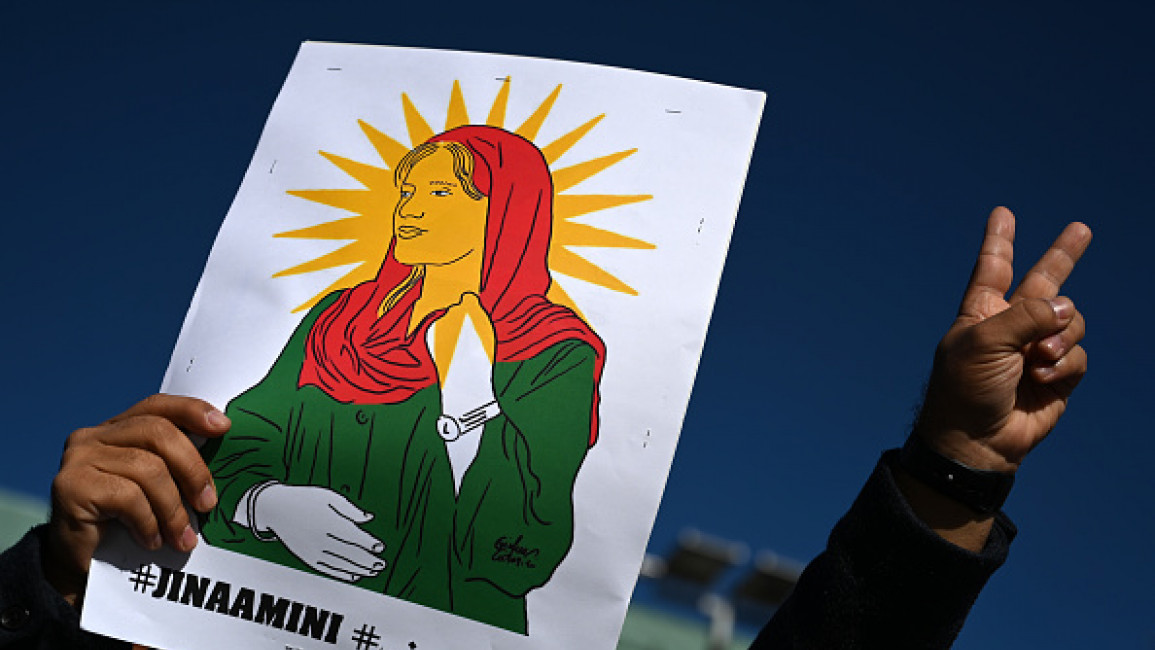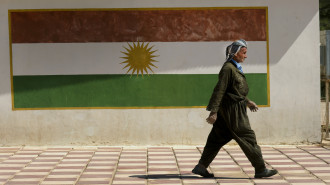

Dozens of Iranian cities and towns have been gripped by a relentless wave of anger since 16 September, when 22-year-old Iranian Kurd Mahsa Amini – or Jina Amini, going by her Kurdish birth name - died in the custody of the Islamic Republic's morality police after she was arrested for allegedly breaching the strict dress code for women.
The protests, which cut across ethnic and social class divides, have been particularly intense in the country’s minority Kurdish population, which was the first group to rise up and unleash their fury on a leadership they claim has long oppressed them.
The nationwide demonstrations began in north-western Iran, where Kurds make up about 10 percent of the Iranian population, before quickly spreading to the rest of the country - and they show no signs of slowing despite a rising death toll.
Since the first day of demonstrations, both Kurdish identity and women’s rights have been key components of the protest movement, with people taking to the streets in Amini’s hometown of Saqqez singing revolutionary Kurdish songs.
"Kurdish women in Iran are twice oppressed; as women facing a theocratic regime that is biased against women in virtually every area of life and as Kurds who are discriminated against in everyday life"
“Right after Jina’s funeral, Kurdish women were taking off their hijabs and calling for freedom from the oppressive conditions and state violence that Kurds and all women face in Iran,” Meghan Bodette, the director of research at the Kurdish Peace Institute (KPI), told The New Arab.
With the protest movement following the lead of Kurdistan, the Kurdish cause has rapidly become intertwined with that of other oppressed communities in Iran.
Women across Iran, especially Kurdish women, have been at the forefront of the uprising. They have bravely come out burning their headscarves and cutting their hair to protest the country’s hijab regulations, and to demand freedom from state repression and patriarchy and the right to choose what to do with their own bodies.
Protesters in Kurdistan and throughout Iran have been heard chanting ‘Women, life and freedom’ (or Jin Jîyan Azadî in Kurdish), a demand for women’s liberation emerging from the Kurdish Freedom Movement, which has turned into the protest movement’s motto alongside ‘Death to the dictator’ and other anti-regime slogans.
For Elif Sarican, an activist in the Kurdish Women's Movement, it is fundamental to recognise that Amini was allegedly killed “as a Kurdish woman”, something that subsequently resonated with many Kurds, particularly women, and sparked unrest across all four regions of Kurdistan.
“The fact that she [Jina] was Kurdish is important because the reality of an added layer of violence Kurdish women are faced with in these areas is what is felt as a universal experience,” the Kurdish activist told TNA.
Kurds make up one of the Middle East’s largest ethnic groups, with a population scattered between west and eastern Iran, northern Iraq, northern Syria, and south-eastern Turkey.
The government has been trying to suppress the unrest with deadly force, mass arrests, and by curbing Internet access. Its response has been especially heavy in Kurdish areas of the country’s northwest, with cities militarised by the Iranian regime, and where violent confrontations between demonstrators and security forces have been reported along with night raids and the arrests of those participating in the protests.
|
|
The Norway-based Iran Human Rights NGO has recorded at least 154 people killed in Iran’s crackdown since the protests began, with hundreds more injured and thousands arrested.
According to Hengaw, an independent organisation that monitors violations in Iran’s Kurdistan, 23 protesters are among the dead with 1,138 wounded in the Kurdish provinces alone. More than 2,000 Kurdish citizens have been arrested by Iranian security agencies in the last two weeks, based on data gathered by the Kurdish rights group.
Real numbers are likely higher given that Iranian regime repression and Internet restrictions make it difficult to report actual figures.
Two weeks ago, a group of Kurdish female political prisoners went on hunger strike at Sanandaj Prison facility to protest the degrading treatment of women arrested during the demonstrations, as well as the unlawful detention of Kurds in Iran.
"Kurdish provinces are among the most deprived in Iran, have some of the highest unemployment rates, and have limited access to basic services"
Besides going after the Kurdish minority at home, Tehran has been launching strikes against Kurdish opposition groups based in Iraq's Kurdistan region (KRI) accusing them of fuelling the protests. Iranian Kurdish rebel groups have long been based in northern Iraq and come under frequent cross-border attacks by Iran’s Revolutionary Guard Corps (IRGC).
Kurdish provinces are among the most deprived in Iran, have some of the highest unemployment rates, and have limited access to basic services. The Iranian state's economic and development policies in Kurdistan are known to be exploitative.
“Kurdish areas have been always deliberately underdeveloped and impoverished with central state policies making them more dependent on the state that colonises them and [makes them] easier to control,” Sarican asserted.
In discussing cultural assimilation, she observed that Iran’s intent is to create what it thinks should be a “homogeneous society”, and therefore to remove all forms of diversity, which means the expressions of particular ethnic groups are either integrated into a general identity or forbidden.
Mainly Sunni Muslims in Shia-dominated Iran, Kurds represent the largest oppressed group under the Islamic Republic today and the monarchy before it. They form nearly half of political prisoners in the country despite being a small portion of the population, activists are often sentenced to many years in prison, and those who take part in demonstrations receive severe penalties.
Kurdish language publications and cultural activities are restricted, teaching the Kurdish language is prohibited, and the use of Kurdish names is banned in many cases.
“Kurdish women in Iran are twice oppressed; as women facing a theocratic regime that is biased against women in virtually every area of life and as Kurds who are discriminated against in everyday life,” Bodette highlighted.
|
|
She called attention to the central role Kurdish women have played in the struggle for “women’s liberation” and “Kurdish liberation” in Iran throughout the decades as they stand alongside all other women in a united battle against misogynist policies imposed by ultra-religious leaders.
“Any demand for the liberation of women is necessarily a demand for the end of a theocratic dictatorship,” the KPI research associate argued. “The struggle of women for their own freedom can lead to the freedom of society”.
Bodette said that, given the autocratic nature of the Iranian state, any woman challenging the status quo is seen as a threat to its authority. She pointed out that Kurdish women are a “double threat” since they resist policies of both misogynistic and nationalist oppression.
Kurdish activist Elif Sarican underscored the importance of building solidarity within the women’s freedom movement to include Iran’s different ethnicities and their specific struggles. “It’s essential that Iranian people as a whole see that their push for transformation and struggle for liberation will never be meaningful without them including marginalised groups like the Kurds and their specificities,” she maintained.
"Kurdish women are a 'double threat' since they resist policies of both misogynistic and nationalist oppression"
Similarly, Iranian Kurdish academic Allan Hassaniyan contended in a recent analysis that in order to keep the struggle against Iran’s Islamic regime unified the “differences in demands” voiced by people from different backgrounds in the country should be respected.
“Because of the marginalisation that Kurds face and their history of struggle, the recognition of Kurdish concerns by progressive forces is an important precondition for fundamental change in Iran to succeed,” he wrote.
The current demonstrations are the most significant anti-government rallies witnessed in Iran in more than a decade. The ‘Green Movement’ of 2009 saw large-scale protests against election results widely believed to be rigged. In 2019, Iranians rallied over fuel price hikes, and demonstrations took place earlier this year over the cost of living.
Today’s protests appear to be markedly inclusive and have support from an array of social classes and ethnic groups, posing a new challenge to the very system that underpins the Islamic Republic.
Alessandra Bajec is a freelance journalist currently based in Tunis.
Follow her on Twitter: @AlessandraBajec





 Follow the Middle East's top stories in English at The New Arab on Google News
Follow the Middle East's top stories in English at The New Arab on Google News


